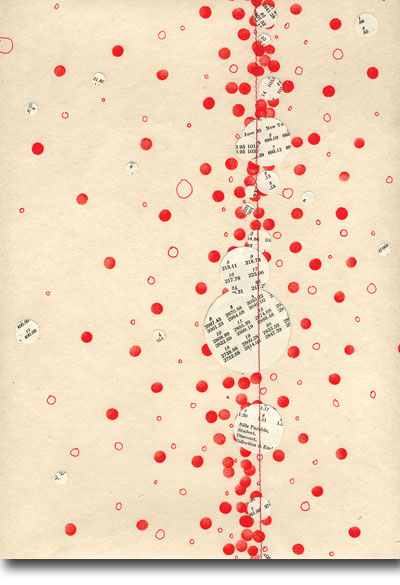Aug 2008

PORTLAND
Tsilli Pines at Ogle
In her debut at Ogle,
Tsilli Pines conjures an intimate jewel box of a show, resplendent with tiny
pearls (most pieces are 10 by 17 inches) that impress without preening.
Comprised of pigment and found objects on rice paper, the works are variations
on a sparing, meticulous theme, their elements positioned in rhythmic
compositions of cut paper: some abstract, some semi-abstract, a few figurative,
all carried off with a quiet, winning elegance. Pines carries a graphic design
sensibility into the works, dispersing paper circles and red dots in works such
as Compounding, with its duet between verticality and diffusion, and Balloon
Payments, while packing the dots more densely in In the Red. The titles—as well
as the red-and-black color palette—reflect the artist’s interest in the roles of
numbers and money in everyday life. Notably, much of the found paper is from old
accounting ledgers and check balance books. In pivoting piece to piece between
dispersal and compactness, the works give the impression of breathing, or of
expanding and contracting like an animal—or the stock market.
In Risk
Tolerance, cut-out circles are connected by cotton thread, imparting a more
literal feel without devolving into preciousness. Other pieces suggest sunrays
(Annual Report, Bottom Line, and Piece of the Pie), flowers (Fruit of our
Labor), root systems (Leveraged and Profit and Loss), Emmentaler cheese (Missing
Assets and Cutting Losses), and the music of the spheres (Bad Credit), with the
thread sometimes loose and sometimes sewn. Despite their clichéd and perhaps
overreaching titles, there is something about the daintiness of the imagery and
fastidiousness of execution that whispers of feminist critique and the resurgent
craft movement. Indeed, Pines’ artist statement invokes the disparity between
sewing thread as a traditionally feminine medium and the historically
male-dominated fields of accounting and finance, with which this body of work is
concerned. That the show succeeds in illuminating this disparity in a way that
is neither strident nor patronizing is a testament to the visual and conceptual
elegance she is able to condense into a minimum of chromatic and material
components.
